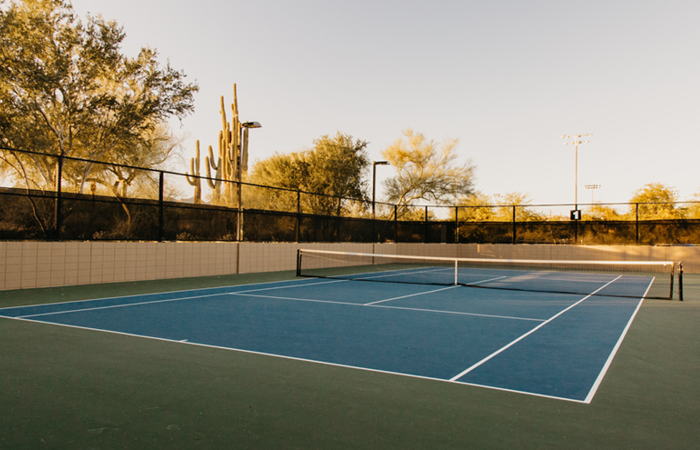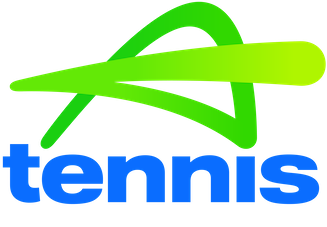
As we come into the colder winter months of the year, it is time for clubs to consider the maintenance regime they apply to their courts. For grass courts, this will mean planning with the greenskeeper on the program to be applied at the back end of the winter season while resting the courts altogether with no play. For clubs with hardcourts, regular maintenance is vital to ensure the longevity and playability of all court surfaces.
Well maintained acrylic surfaces have a life expectancy of between 7 – 10 years (pavement life expectancy is 20+ years), with manufacturers typically offering an acrylic product warranty of between 3 – 5 years, depending on the product. An acrylic surfaced court requires the application of multiple layers of acrylic materials (e.g. resin, paint etc.) on a hardcourt pavement, typically concrete or asphalt. The speed of the acrylic surface is dictated by the quantity and particle shape of silica sand mixed through the acrylic layers.
While acrylic hardcourts are a low maintenance surface requiring only occasional maintenance to ensure long-term performance – maintenance is required!
The following advice is generic and should be verified by the acrylic manufacturer / installer. Performance of the underlying pavement is beyond the scope of routine maintenance. Also, maintenance of other equipment should occur (such as fencing, lighting, nets and posts, paths and viewing areas and buildings) which will be addressed in future articles.
Removal of debris / foreign matter
Removal of debris and foreign matter from the court surface should occur to minimise the risk of abrasive wear or gouging, and to manage playability and maintain true ball bounce. If tree sap or bird excrements are left on the court surface they can cause delamination to the acrylic, so should be cleaned off ASAP with cool and soapy water and a soft sponge. Should mould and mildew areas appear, advice and supply of a cleaning product be sought directly from the acrylic manufacturer / installer.
Removal of standing water
Standing water on acyclic surface can accumulate dirt and debris resulting in stains across the surface. Standing water should be removed as often as possible using a squeegee. A check of drains should also occur to ensure these are unblocked and to allow rain water to freely leave the court.
Regular Surface Clean
An acrylic court should be professionally pressure washed at least once per two years, depending on the site location. It is recommended that this be undertaken by an experienced professional. Tennis SA can provide advice on suitable contractors. The usual cost for 2-3 courts to be cleaned in a day is between $500-$600 +GST (additional charges may apply due to travel).
Repairing surface cracks
Repairing cracks in acrylic is recommended to prevent moisture migration under acrylic surface, which may lead to delamination. It must be noted that surface cracks are never permanently repaired without base / pavement reconstruction or rectification works are undertaken. It is recommended that advice and supply of the filler product be sought directly from the acrylic manufacturer / installer.
Resurfacing
A regular maintenance regime for tennis courts may include court resurfacing every 7 – 10 years. Depending on the initial design and construction of the pavement, an acrylic tennis court may be resurfaced several times before base reconstruction is required.
A Routine Maintenance Program is suggested as follows:
| Daily | Remove debris such as gumnuts or branches that can be a trip hazard. Sweep with a soft bristled broom or a power blower. Check for accumulation or dirt at gate areas. As required, remove laying or pooling water using a squeegee. |
| Weekly | Sweep or power blow the court surface. |
| Monthly | Dampen the courts with a water mist and treat stains and dirty areas with as needed with a squeegee and/or soft sponge. |
| Annually | Inspect all court fixtures for damage and replace as needed. Carefully inspect shaded areas for mould and mildew growth. |
| Bi-annually | Professionally pressure wash the courts using <1500 psi to avoid surface damage. Pressure wash starting from the high point of the court. |
Maintenance Budget
Hardcourts have an ongoing maintenance cost which a club will need to consider as part of its annual budgeting. As a guide, a club may consider the following for their budget:
- Squeegee – $300 each – 1-2 per court – 3-5 years before replace rubber blades ($40 replacement)
- Brooms – $50 each – 1-2 per court – 3-5 years
- Petrol or Battery Power Blower – $300 – 1 for venue – 10 years (fuel costs and jerry can)
- Acrylic Cleaning Product – check cost, quantity and expected life with your acrylic manufacturer / installer
- Acrylic Crack Fill Product – check cost and quantity with your acrylic manufacturer / installer – resurface cycle
- Professional Pressure Clean – $600 per court – 2-3 years
- Acrylic Resurface – $1000 per year per court – 8 years
For assistance on planning your maintenance program, please contact your acrylic manufacturer / installer or Tennis SA.

